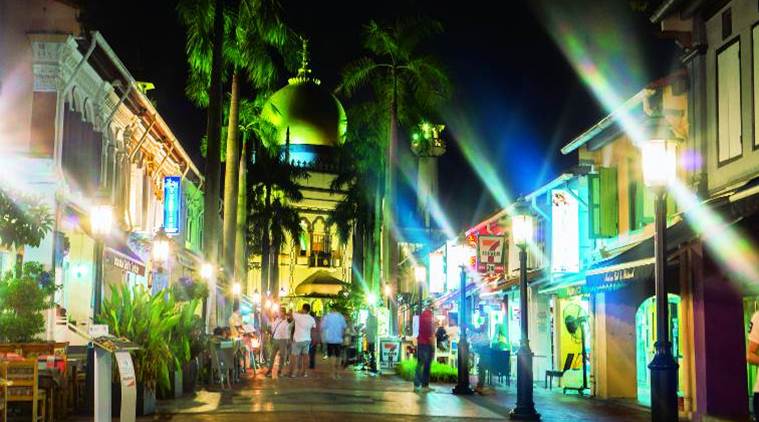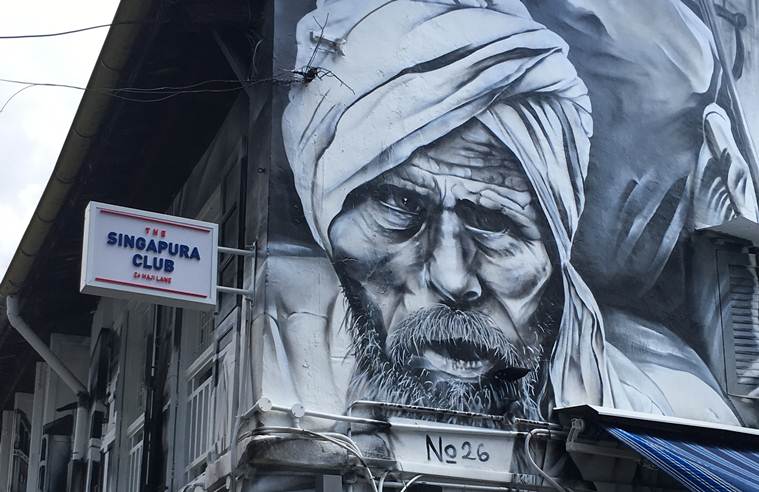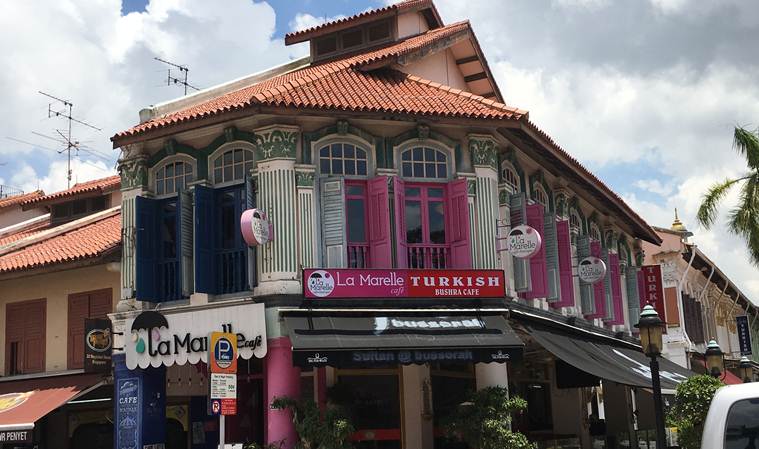GUJARAT / SINGAPORE :
Away from its cookie-cutter malls, Singapore’s Kampong Glam district is a different universe – a delightful cultural mix.

At Haji Lane, in Kampong Glam, one of Singapore’s most atmospheric districts, vibrant graffiti art — African tribal figures, surreal motifs, arresting visages — stares back at me. The psychedelic surfaces on the walls appear gilded in the afternoon sun. Embedded within the walls are colourful windows of pre-war shop houses that occasionally fling open to reveal the owner’s face. The picturesque lane is a photographer’s delight and I click a dozen photos a minute. Nobody seems to mind. People stand and talk in doorways of shops brimming with cult labels and vintage clothing. Hookah bars and cafes spill on to the sidewalk. This is a universe away from Singapore’s crowded, cookie-cutter malls.
“Haji Lane is named after the Haj, the pilgrimage undertaken by Muslims to Mecca and Medina,” says my guide Naseem Huseini, a second-generation Gujarati-Singaporean, as I move around, entranced by my new geography. “It provided accommodation for poor Malay families and lodging for pilgrims.” Today, reasonable rents and a prime location have turned the lane into a hub for upcoming designers and artists, the concept very similar to Delhi’s Hauz Khas Village. I peer through the shops’ doorways and spot artists at work — sculpting, etching, painting and tailoring. The narrowness of the shops’ facades is beguiling though. For as I peep in, I find them stretching way, way beyond. Naseem explains that the shops were built so because in the ’60s and ’70s, the government taxed property owners on the number of windows the houses had!

At the end of Haji Lane, we are swamped by the cheerful chaos of central Kampong Glam dominated by shops catering to the Malay/Muslim community: frame makers, tombstone carvers, textile wholesalers, spice traders, perfumers, Muslim food caterers, and retailers of gemstones, and religious paraphernalia. The Indonesian batik textiles and Muslim prayer carpet shops have been here for almost a century.
Kampong Glam, or KG, as it’s popularly called, is named after the gelam tree whose bark was used by the Orang Laut Malays (the indigenous sea nomads and gypsies of Singapore) to make awnings and sails. “The tree’s timber went into making boats or was used as firewood. Its fruit was ground and used as a spice and its leaves boiled to relieve rheumatism and cramps,” says Naseem.
History whispers from every corner of KG. And its streets have evocative monikers — Bussorah, Baghdad, Kandahar. Earlier, many of them were synonymous with specific trades. For instance, North Bridge Road housed tailors and Chinese-run goldsmith shops, Sultan Gate was dominated by stone masons and blacksmiths, while Bussorah Street hosted centres for pilgrimage services.

“In the early days,” elaborates Naseem, “KG was the exclusive preserve of Sultan Hussein and his family, and the rich Malay and Arab merchants. Later, the Bugis, Javanese and the Chinese also arrived. These people set up kampongs or villages, and built shop houses to expand their businesses.” The kampongs were row wooden houses with steep roofs of corrugated iron or thatch, gathered around a communal centre. Today, these structures stand demolished in the quest for modernisation.
While trying to negotiate KG’s uneven sidewalks, my eyes are constantly drawn to its architectural wonders. The Istana Kampong Glam, the Sultan’s palace, impresses with its exquisiteness. The golden dome and exquisite minarets of the Sultan Mosque — Singapore’s most important mosque and the pivot around which KG seems to flow — seem to scrape the sky.
KG’s street life unspools more engaging sights. We bump into Muslim men in lungis and white skull caps and abaya-clad women, who appear incongruous in Singapore’s landscape, where fashion-forward men in dapper suits and ladies in skyscraper-heels rule. In Bussorah Street, we’re engulfed by shops selling Indonesian batiks, leather bags, Persian carpets, kebaya dresses and handmade perfumes. A cluster of old stores in the shadow of Sultan Mosque sell traditional textiles, carpets and perfumes.
Partially to escape the catatonic heat, we stride into a cool, inviting wood-panelled shop chock-full of hundreds of glittering vials of custom-made perfumes. This is the iconic Jamal Kazura Aromatics, one of Singapore’s oldest perfumeries. A family-run business since 1933, the shop stocks readymade scents as well as fragrances customised from pure essential oils. There are massage oils, scented body soaps and shower creams too. The shop’s cut-glass perfume bottles are as intriguing as the scents. Kazura, the store owner, explains that his shop does double duty as his workshop. Like a modern-day alchemist, he creates scents from hundreds of ingredients sourced from around the world. We spot bits of sandalwood from India jostling for space with frankincense from Africa, myrrh from the Middle East, patchouli from Indonesia and lavender from France.
Kazura adds that when his grandfather, an Indian Muslim, arrived in Singapore in 1933, he started the business and expanded it later to Malaysia and India. “Blending perfumes is as much an art as a science,” he says. “Perfumers have to rigorously train their noses to distinguish between different scents. The provenance of perfumes is in ancient Egypt and Mesopotamia, and they still play a vital role in the Arab world. A good fragrance takes one closer to Allah,” he adds philosophically.
From Arab Street, we amble into Baghdad Street. “Would you like to try teh?” Naseem asks me, two hours into our walk. What’s that? I ask her. In response, the lady steers me to a hole-in-the-wall kiosk located at the junction of Bussorah and Baghdad Street. Here, an elderly white bearded gentleman is making tea at a stall ironically named “No Name Teh Sarabat” stall! Ahmed (65) has been selling Malaysian “pulled tea” for 40-odd years at this very spot and is quite a cult figure. His shop is abuzz with old Malay men sipping fragrant tea available in two flavours — teh tarik infused with rose essence and teh alia (ginger tea). The beverage is cheap. For a Singapore dollar and five cents, we’re soon cupping our hands around a mug full of a brew of black tea, milk and sugar. Ahmed explains that the technique of “tariking” (the process of ‘pulling’ tea from one cup to another) isn’t just a show, but actually makes the tea (teh) taste more delicious.
Food is an omnipresent motif in KG. Hip gelaterias, bistros and cafes pepper its warren landscape. Street after street resonates with the bustle of chairs and conversation, and the clatter of plates and glasses. Iranian, Lebanese, Turkish, Middle-eastern, Indonesian, Thai and Chinese, the repertoire is eclectic. There’s nasi padang (steamed rice served with various dishes) and Malay kuih (cakes), Middle Eastern falafels, sushi/sashimi, Lebanese meats and even quesadillas. At Alaturka, an award-winning Turkish restaurant, our taste buds are tantalised by succulent kebabs, soft pita bread and piquant dips glistening with unctuous olive oil. There’s mint-cinnamon tea to wash it all down with. As I stride out of KG, I feel I’ve learnt a thing or two about Singapore’s rich cultural heritage as well as the vital message it delivers — that plurality and diversity can thrive only in the soil of tolerance and inclusiveness.
source: http://www.indianexpress.com / The Indian Express / Home> Lifestyle> Destinations of the Week / by Neeta Lal / December 18th, 2016








